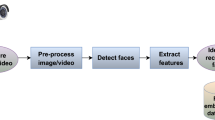Abstract
The findings of some of the key studies that have examined the contribution of different bands of spatial information, specified in terms of cycles per face, to face recognition, and identification are reviewed. Based on findings from studies of low-, high-, and band-pass filtering, it is concluded that neither low facial scales nor high facial scales are optimal. Instead, a center range of facial scales, approximately 8-16 cycles per face, appears to make the greatest contribution to the recognition process. A study of identification of band-pass filtered faces is reported that reinforces the view derived from the literature. This indicated that a band with a harmonic mean of 11.1 cycles per face provided the most efficient recognition, with speed and accuracy declining at lower and higher bands.
Similar content being viewed by others
References
Bachmann, T. (1991). Identification of spatially quantised tachistoscopic images of faces: How many pixels does it take to carry identity? European Journal of Cognitive Psychology, 3, 85–103.
Breitmeyer, B.G. (1975). Simple reaction times as a measure of the response properties of transient and sustained channels. Vision Research, 15,1411–1412.
Bruce, V. (1988). Recognising faces. London: Erlbaum.
Bruce, V., Hanna, E., Dench, N., Healey, P., and Burton, M. (1992). The importance of mass in line drawings of faces. Applied Cognitive Psychology, 6, 619–628.
Costen, N.P., Parker, D.M., and Craw, I.G. (1994). Spatial content and spatial quantisation effects in face recognition. Perception, 23, 129–146.
Costen, N.P., Parker, D.M., and Craw, I.G. (1996). Effects of high-pass and low-pass filtering on face identification. Perception and Psychophysics, 58,602–612.
Davies, G.M., Ellis, H.D., and Shepherd, J.W. (1978). Face recognition accuracy as a function of mode of representation. Journal of Applied Psychology, 63, 180–187.
Fiorentini, A., Maffei, L., and Sandini, G. (1983). The role of high spatial frequencies in face perception. Perception, 12, 195–201.
Galper, R.E. (1970). Recognition of faces in photographic negative. Psychonomic Science, 19, 207–208.
Harmon, L.D. (1973). The recognition of faces. Scientific American, 229,70–83.
Hayes, T., Morrone, M.C., and Burr, D.C. (1986). Recognition of positive and negative bandpass-filtered images. Perception, 15,596–602.
O'Toole, A.J., Millward, R.B., and Anderson, J.A. (1988). A physical system approach to recognition memory for spatially transformed faces. Neural Networks, 1, 179–199.
Parker, D.M. (1980). Simple reaction times to the onset, offset and contrast reversal of sinusoidal grating stimuli. Perception and Psychophysics, 28, 365–368.
Parker, D.M., Lishman, J.R., and Hughes, J. (1996). Role of coarse and fine spatial information in face and object processing. Journal of Experimental Psychology: Human Perception and Performance, 22,1448–1466.
Parker, D.M. and Salzen, E.A. (1977). Latency changes in the human visual evoked potential to sinusoidal gratings. Vision Research, 17, 1201–1204.
Pearson, D.E. and Robinson, J.A. (1985). Visual communication at very low data-rates. Proceedings of the IEEE, 73,795–811.
Peli, E., Young, G.M., Goldstein, R.B., and Trempe, C.L. (1991). The critical spatial frequency for face recognition. Noninvasive Assessment of the Visual System, Technical Digest, Vol. 1, Optical Society of America, Washington D.C., pp. 105–108.
Phillips, R.J. (1972). Why are faces hard to recognise in photographic negative? Perception and Psychophysics, 12,425–426.
Riley, D. and Costall, A. (1980). Comment on “Recognition of faces in the presence of two-dimensional sinusoidal masks” by Tieger and Ganz. Perception and Psychophysics, 27,373–374.
Sergent, J. (1986). Microgenesis in face perception. In: H.D. Ellis. M.A. Jeeves, F. Newcombe, and A. Young (eds.), Aspects of face processing (pp. 17–73). Dordrecht, The Netherlands: Martinus Nijhoff.
Author information
Authors and Affiliations
Rights and permissions
About this article
Cite this article
Parker, D.M., Costen, N.P. One extreme or the other or perhaps the golden mean? Issues of spatial resolution in face processing. Curr Psychol 18, 118–127 (1999). https://doi.org/10.1007/s12144-999-1021-3
Issue Date:
DOI: https://doi.org/10.1007/s12144-999-1021-3




